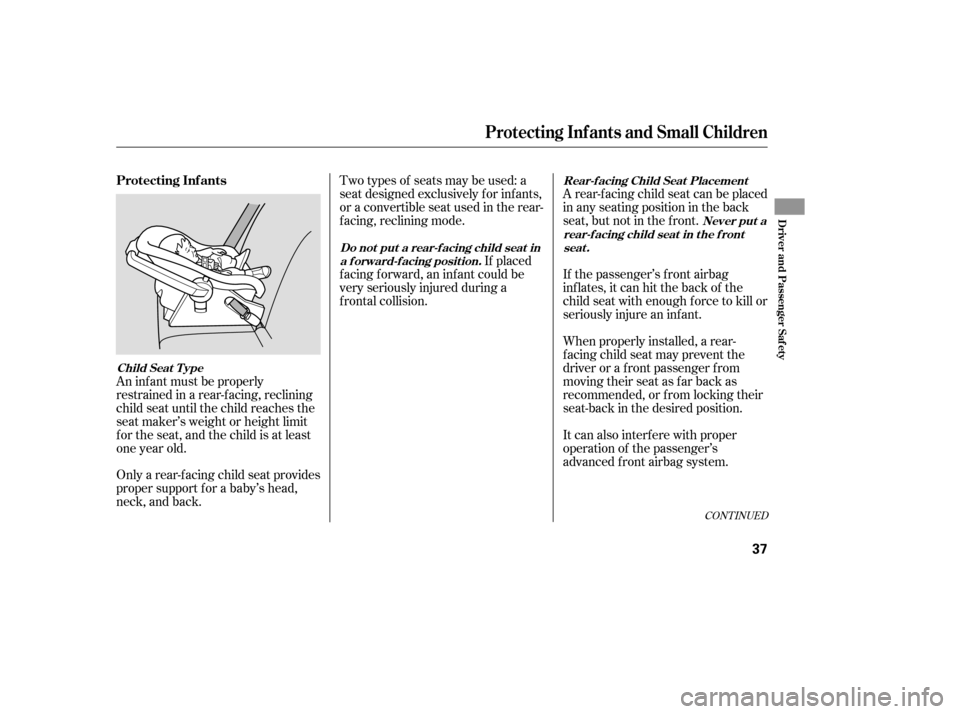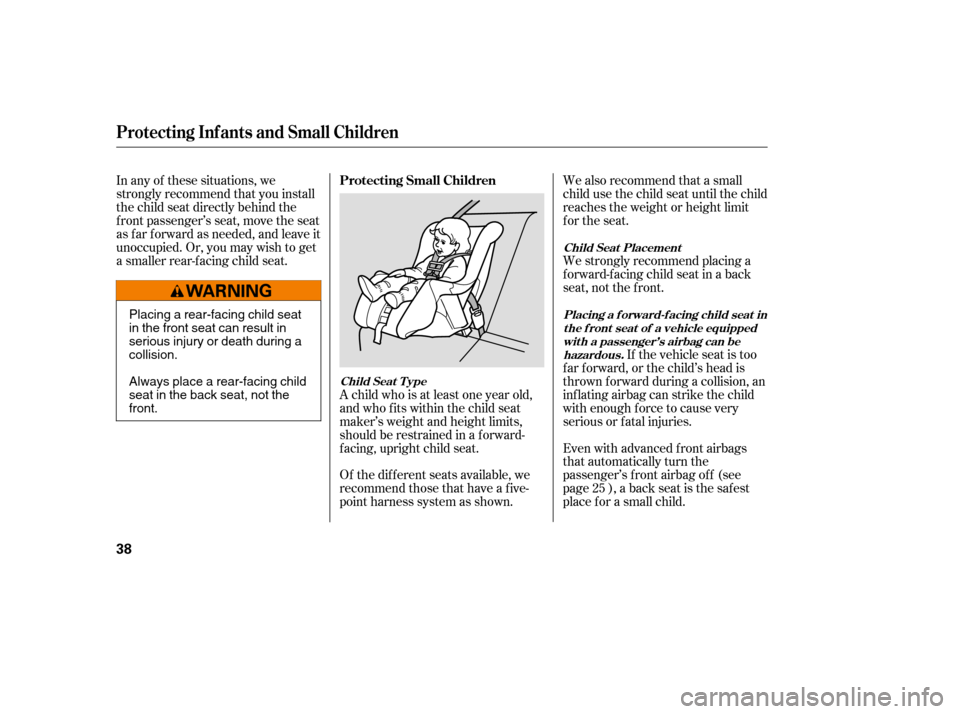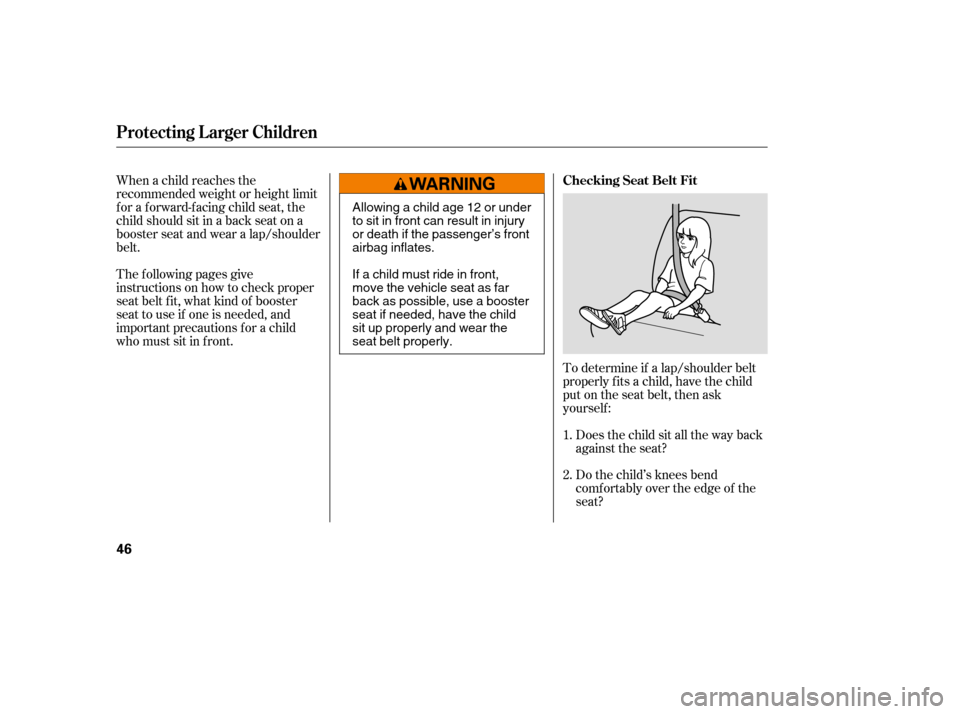Page 39 of 303

An inf ant must be properly
restrained in a rear-f acing, reclining
child seat until the child reaches the
seat maker’s weight or height limit
f or the seat, and the child is at least
one year old.
Only a rear-f acing child seat provides
proper support f or a baby’s head,
neck, and back.Two types of seats may be used: a
seat designed exclusively f or inf ants,
or a convertible seat used in the rear-
f acing, reclining mode.
If placed
f acing f orward, an inf ant could be
very seriously injured during a
f rontal collision. A rear-f acing child seat can be placed
in any seating position in the back
seat, but not in the f ront.
If the passenger’s f ront airbag
inflates, it can hit the back of the
child seat with enough f orce to kill or
seriously injure an inf ant.
When properly installed, a rear-
f acing child seat may prevent the
driver or a f ront passenger f rom
moving their seat as far back as
recommended, or f rom locking their
seat-back in the desired position.
It can also interf ere with proper
operation of the passenger’s
advanced front airbag system.
CONT INUED
Protecting Inf ants
Child Seat T ypeDo not put a rear-f acing child seat in
a f orward-f acing position. Rear-f acing Child Seat Placement
Never put a
rear-f acing child seat in t he f ront seat .
Protecting Inf ants and Small Children
Driver and Passenger Saf ety
37
�����—�����—�
�
�y�
����
����
���y���
�(�+���������y���������y
Page 40 of 303

Of the different seats available, we
recommend those that have a f ive-
point harness system as shown.
In any of these situations, we
strongly recommend that you install
the child seat directly behind the
f ront passenger’s seat, move the seat
as far forward as needed, and leave it
unoccupied. Or, you may wish to get
a smaller rear-f acing child seat.
A child who is at least one year old,
and who fits within the child seat
maker’s weight and height limits,
should be restrained in a f orward-
facing, upright child seat. Even with advanced front airbagsthat automatically turn the
passenger’s front airbag off (see
page ), a back seat is the saf est
place f or a small child.If the vehicle seat is too
f ar f orward, or the child’s head is
thrown f orward during a collision, an
inf lating airbag can strike the child
with enough force to cause very
serious or f atal injuries.
We strongly recommend placing a
forward-facing child seat in a back
seat, not the f ront.
We also recommend that a small
child use the child seat until the child
reaches the weight or height limit
for the seat.
25
Protecting Small Children
Child Seat T ype
Placing a f orward-f acing child seat in
t he f ront seat of a vehicle equipped
with a passenger’s airbag can be hazardous.
Child Seat Placement
Protecting Inf ants and Small Children
38
Placing a rear-facing child seat
in the front seat can result in
serious injury or death during acollision.
Always place a rear-facing child
seat in the back seat, not thefront.
�����—�����—�
�
�y�
����
��������y���
�(�+���������y���������y
Page 47 of 303

When a child reaches the
recommended weight or height limit
for a forward-facing child seat, the
child should sit in a back seat on a
booster seat and wear a lap/shoulder
belt.
The f ollowing pages give
instructions on how to check proper
seat belt f it, what kind of booster
seat to use if one is needed, and
important precautions f or a child
who must sit in f ront.To determine if a lap/shoulder belt
properly f its a child, have the child
put on the seat belt, then ask
yourself :Does the child sit all the way back
against the seat?
Do the child’s knees bend
comf ortably over the edge of the
seat?
1. 2.
Checking Seat Belt Fit
Protecting L arger Children
46
Allowing a child age 12 or under
to sit in front can result in injury
or death if the passenger’s front
airbag inflates.
If a child must ride in front,
move the vehicle seat as far
back as possible, use a booster
seat if needed, have the child
sit up properly and wear the
seat belt properly.
�����—�����—�
�
�y�
����
��������y���
�(�+���������y�������
�y
Page 49 of 303

A child may continue using a booster
seat until the tops of their ears are
even with the top of the vehicle’s or
booster’s seat-back. A child of this
height should be tall enough to use
the lap/shoulder belt without a
booster seat.If the passenger’s f ront airbag
inf lates in a moderate to severe
f rontal collision, the airbag can cause
serious injuries to a child who is
unrestrained, improperly restrained,
sitting too close to the airbag, or out
of position.
A side airbag also poses risks. If any
part of a larger child’s body is in the
path of a deploying side airbag, the
child could receive possibly serious
injuries.Of course, children vary widely. And
while age may be one indicator of
when a child can saf ely ride in f ront,
there are other important f actors you
should consider.
To saf ely ride in f ront, a child must
be able to f ollow the rules, including
sitting properly, and wearing the seat
belt properly throughout a ride.
Physically, a child must be large
enough f or the lap/shoulder belt to
properly f it (see pages and ). If
the seat belt does not f it properly,
with or without the child sitting on a
booster seat, the child should not sit
in f ront.
The National Highway Traffic Safety
Administration and Transport
Canada recommend that all children
age 12 and under be properly
restrained in the back seat.
14 46
When Can a L arger Child Sit in
Front
Physical Size
Maturity
Protecting L arger Children
48
�����—�����—�
�
�y�
����
��������y���
�(�+���������y���������y
Page 90 of 303
The height of your driver’s seat is
adjustable. To raise the seat bottom,
repeatedly pull up the lever on the
outside of the seat cushion. To lower
the seat, push the lever down
repeatedly.
Make all seat adjustments bef ore
you start driving.To get into the rear seat on the
driver’s side, open the door and pull
up on the seat-back adjustment lever.
The seat-back will tilt f orward to
allow easier entry to the rear seat.
To use the console lid as an armrest,
slide it to one of its three positions.
CONT INUED
On all models except DX
Driver’s Seat Height A djustment A rmrest Rear Seat A ccess
Driver’s Side
Seats
Inst rument s and Cont rols
93
SEAT-BACK ADJUSTMENT LEVER
�����—�����—�
�
�y�
�������������y���
�(�+���������y���������y
Page 92 of 303
CONT INUED
See page f or important saf etyinf ormation and a warning aboutimproperly positioning head restraints. 13
Your vehicle is equipped with head
restraints in all seating positions to
help protect you and your
passengers f rom whiplash and other
injuries.
They are most ef f ective when you
adjust them so the center of the back
of the occupant’s head rests against
the center of the restraint.The head restraints adjust f or height.
You need both hands to adjust a
restraint.Donotattempttoadjustit
while driving. To raise it, pull upward.
To lower the restraint, push the
release button sideways, and push
the restraint down.
Seats
Head Restraints
A djust ing t he Head Rest raint
Inst rument s and Cont rols
95
FRONT
LEGS SEAT-BACK RELEASE
BUTTON
�����—�����—�
�
�y�
���������
���y���
�(�+���������y���
�����y
Page 93 of 303
When a passenger is seated in the
rear center seating position, the
center head restraint should be
adjusted up or down, to match the
passenger’s height.To remove a head restraint f or
cleaning or repair, pull it up as f ar as
it will go. Push the release button,
then pull the restraint out of the seat-
back.
When reinstalling a head restraint,
put the legs back in place. Then
adjust it to the appropriate height
while pressing the release button.
Make sure the head restraint locks
in position when you reinstall it.
Seats
Removing t he Head Rest raint
96
RELEASE BUTTON
Rear Center Position
LEG
SEAT-BACK
Failure to reinstall the head
restraints can result in severe
injury during a crash.
Always replace the head
restraints before driving.
�����—�����—�
�
�y�
�������������y���
�(�+���������y���
���
�y
Page 274 of 303
�Î �Î�Î�Î
�Î �Î �Î
�Î
�Î�Î
�Î�Î
�Î�Î
�Î�Î
Specif ications
296
Dimensions
Engine
Weights
Seating Capacities 174.8 in (4,440 mm)
68.9 in (1,751 mm)
53.5 in (1,358 mm)
104.3 in (2,650 mm)
59.0 in (1,499 mm)
59.9 in (1,522 mm)
Length
Width
Height
Wheelbase
Track
Type
BorexStroke
Displacement
Compression ratio
Spark plugs
Spark plugsWater cooled 4-stroke
SOHC VTEC , DOHC i-VTEC
4-cylinder gasoline engine
3.19 x 3.44 in (81.0 x 87.3 mm)
3.39x3.39in(86x86mm) 110 cu-in (1,799 cm
)
122 cu-in (1,998 cm)
10.5 11.0
NGK:
DENSO: IZFR6K-11SSKJ20DR-M11SIFR7G-11KSSK22PR-M11S
Gross vehicle weight rating See the certification label attached to the driver’s doorjamb.
Total
FrontRear
32
5
60.2 in (1,528 mm)
FrontRear
NGK:
DENSO:
1:2: DX, Canadian DX-G, LX, EX, EX-LSi
1:2:
LX, Canadian DX-G (M/T), EX, EX-L
DX, Canadian DX-G (A/T)
1 2 12
1 2 1
2
12
12
�����—�
���—�����y�
�������������y���
�(�+���������y�������
�y